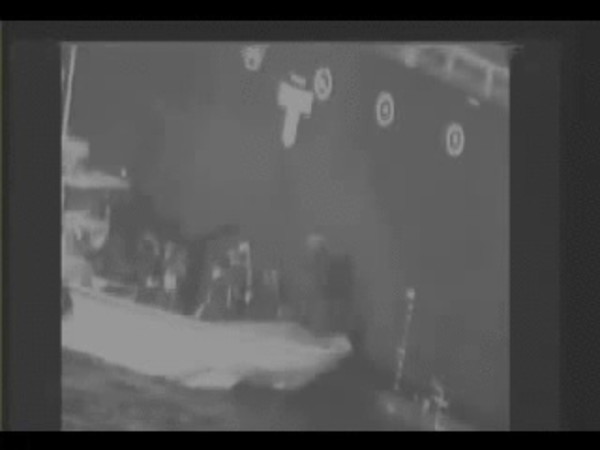

Editor’s Note: This article originally appeared on Radio Free Europe/Radio Free Liberty.
The U.S. military has released a video it says implicates Iran’s Islamic Revolutionary Guard Corps (IRGC) in the attack on two oil tankers in the Gulf of Oman, the latest violent incident the United States and its allies blame on Tehran.
The U.S. Central Command on June 13 said the video shows crews from IRGC boats removing what looks like an unexploded mine from the side of one of the two attacked oil tankers.
“At 4:10 p.m. local time, an IRGC Gashti Class patrol boat approached the M/T Kokuka Courageous and was observed and recorded removing the unexploded limpet mine from the M/T Kokuka Courageous,” Navy Captain Bill Urban, a Central Command spokesman, said in a statement.
Officials told CNN the Pentagon believes it was an attempt by Iranian forces to retrieve evidence of their involvement.
Iran’s mission to the UN late on June 13 said it “categorically rejects the U.S. unfounded claim” that it was involved in the latest attacks in the Gulf of Oman.
In this Powerpoint slide provided by U.S. Central Command damage from an explosion, left, and a likely limpet mine can be seen on the hull of the civilian vessel M/V Kokuka Courageous in the Gulf of Oman, June 13, 2019, as the guided-missile destroyer USS Bainbridge (DDG 96)
(U.S. Navy/U.S. Central Command)

Earlier in the day at the UN, U.S. acting Ambassador Jonathan Cohen called on the Security Council to confront the “clear threat” posed by Tehran in the region.
The attacks “demonstrate the clear threat that Iran poses to international peace and security,” Cohen told reporters following the closed-door Security Council meeting.
Cohen said that “no proxy group in the area has the resources or the skill to act with this level of sophistication.”
“Iran, however, has the weapons, the expertise, and the requisite intelligence information to pull this off,” he said.
“I’ve asked the Security Council to remain seized of the matter and I expect that we will have further conversations about it, and how to respond in the days ahead,” he added.
Cohen said the United States would defend its forces and interests in the region, but he did not give any specifics about potential retaliation and took no questions from reporters.
In this Powerpoint slide provided by U.S. Central Command damage from an explosion, left, and a likely limpet mine can be seen on the hull of the civilian vessel M/V Kokuka Courageous in the Gulf of Oman, June 13, 2019, as the guided-missile destroyer USS Bainbridge (DDG 96)
(U.S. Navy/U.S. Central Command)

Diplomats told AFP that some Council members did not immediately blame Iran, saying there was no clear evidence tying Tehran to the attacks.
However, Saudi Arabia, Iran’s arch-rival and a close U.S. ally, said it had no reason to disagree with the U.S. assessment of Iran’s culpability. “Iran has a history of doing this,” Foreign Minister Adel al-Jubeir told CNN.
British Foreign Secretary Jeremy Hunt told the BBC that “our starting point is to believe” the U.S. view that Iran is to blame for the oil tanker attacks.
He called the attacks “deeply worrying” and said Britain would make its own assessment on the incident in the coming days.
“We are taking this extremely seriously, and my message to Iran is that if they have been involved it is a deeply unwise escalation which poses a real danger to the prospects of peace and stability in the region,” he said.
In Washington, Secretary of State Mike Pompeo blamed Tehran, citing the type of explosives used and what he said was the sophistication of the attacks. He asserted it was part of a campaign to escalate tensions in the region.
“This is only the latest in a series of attacks, instigated by the Islamic Republic of Iran and its surrogates, against the United States and its allies,” Pompeo said.
“And they should be understood in the context of 40 years of unprovoked aggression against freedom-loving nations,” he added.
In the incident, two commercial oil tankers were hit by explosions and caught fire in the Gulf of Oman, prompting the evacuation and rescue of dozens of crew members.
Ship operators said that 21 crew on board the Japanese-owned Kokuka Courageous tanker and 23 on the Front Altair, owned by Norway, were evacuated by nearby vessels after the blasts erupted June 13.
Iranian state media reported that the Iranian navy rescued the 44 and transferred them to an Iranian port, a claim disputed by the United States, which said its Navy had come to the rescue of some of those aboard the ships.
One crewman was said to have been slightly injured.
The incidents come a month after attacks on four tankers off the coast of the nearby United Arab Emirates (U.A.E.) increased tensions between Tehran and Washington and U.S. allies in the Persian Gulf.
On May 12, the four oil tankers — two Saudi, one Norwegian, and one from the United Arab Emirates (U.A.E.) — were damaged in the attacks.
The U.A.E. said initial findings of its investigation pointed to the likelihood that a “state actor” was behind the bombings, but did not specifically name Iran.
Iran also denied being involved in those attacks, and its foreign minister called the timing of the latest incidents suspicious, given that Japanese Prime Minister Shinzo Abe was meeting Supreme Leader Ayatollah Ali Khamenei in Tehran.
“Suspicious doesn’t begin to describe what likely transpired this morning,” Mohammad Javad Zarif said in a post to Twitter.
Copyright (c) 2018. RFE/RL, Inc. Reprinted with the permission of Radio Free Europe/Radio Liberty, 1201 Connecticut Ave NW, Ste 400, Washington DC 20036.